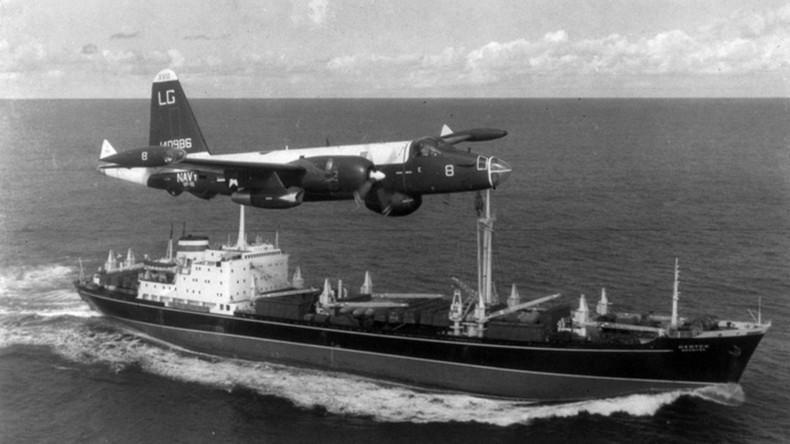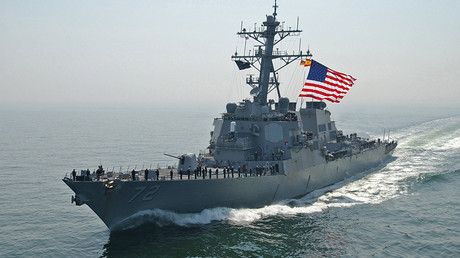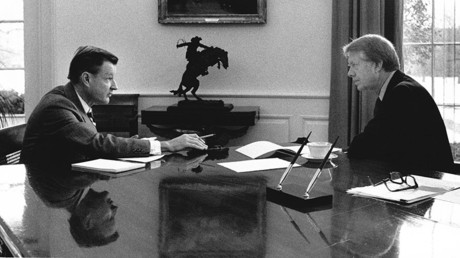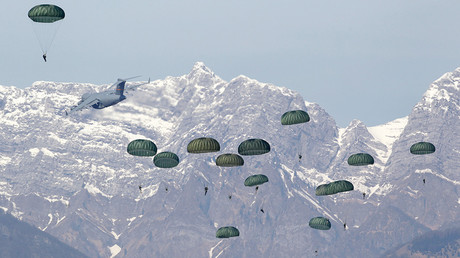A hedgehog down the pants: The lessons of the Cuban Missile Crisis
Neil Clark is a journalist, writer, broadcaster and blogger. He has written for many newspapers and magazines in the UK and other countries including The Guardian, Morning Star, Daily and Sunday Express, Mail on Sunday, Daily Mail, Daily Telegraph, New Statesman, The Spectator, The Week, and The American Conservative. He is a regular pundit on RT and has also appeared on BBC TV and radio, Sky News, Press TV and the Voice of Russia. He is the co-founder of the Campaign For Public Ownership @PublicOwnership. His award winning blog can be found at www.neilclark66.blogspot.com. He tweets on politics and world affairs @NeilClark66

Fifty-five years ago this weekend the world appeared to be on the brink of nuclear war as the Cuban missile crisis unfolded. What are the lessons that can be learned today about the events of October 1962?
It was the great filmmaker Charles Chaplin who commented that life is a tragedy when seen in close-up but a comedy in long-shot. Perspective is everything. If we take a ‘close-up’ view of the Cuban missile crisis, we fail to see the wider issues involved. We’re also likely to fall for the dominant narrative, which has the Soviet Union as the aggressor and the US as the side acting in self-defense. In fact, it was the other way round.
We call it the ‘Cuban missile crisis, ’ but in truth, it was only partly about Cuba. It was just as much about Turkey, and in particular, the fifteen offensive nuclear-tipped intermediate-range Jupiter missiles that had been provocatively deployed there by the US in 1961.
The Soviet Union felt threatened by them and rightly so. They could if launched in a pre-emptive ‘first-strike,' obliterate entire cities in the western USSR, such as Minsk, Kiev, and Moscow, within minutes.
Moreover, the so-called ‘missile gap’ which Kennedy had campaigned on in 1960 against Richard Nixon, actually existed in the US’ favor. The US had around nine times as many nuclear warheads as the Soviet Union. “By 1962, a million US soldiers were stationed in two hundred foreign bases, all threatening the Soviet Union, from Greenland to Turkey, from Portugal to the Philippines,” write Jeremy Isaacs and Taylor Downing, in their book 'Cold War.' “Three and a half million troops belonging to America’s allies were garrisoned around the Soviet Union’s borders. There were American nuclear warheads in Italy, the United Kingdom, and Turkey.”
Nikita Khrushchev, the Soviet leader in 1962, had to do something to quickly change the situation, or else his country was in danger of nuclear annihilation. Remember President Kennedy had already seriously considered the ‘first-strike’ option. Fred Kaplan, the author of The Wizards of Armageddon, records how on July 13, 1961, Kennedy held a National Security Council meeting. Among the items on the agenda: "steps to prepare war plans which would permit the discriminating use of nuclear weapons in Central Europe and... against the USSR."
America’s aggressive policies toward Cuba gave Khrushchev an opportunity to improve his country‘s security. When the cigar-smoking Fidel Castro first come to power in 1959, sweeping away the US-backed leader Batista in a popular uprising, he had not declared his revolution to be a Marxist one. But his program which involved nationalization and clamping down on the business activities of mobsters like Meyer Lansky, inevitably put him on a collision course with Washington.
In December 1960, the Eisenhower administration had already endorsed a scheme to invade Cuba to topple Fidel. John Kennedy, who became President in January 1961, inherited this ’cunning plan’ and went along with it. The result was the Bay of Pigs fiasco. Blackadder's Baldrick really couldn't have come up with anything more disastrous.
Understandably, Castro now declared a socialist revolution and turned to Moscow for assistance. Khrushchev saw a golden opportunity to “throw a hedgehog at Uncle Sam’s pants.”
An agreement was made with the Castro brothers, whereby Cuba would be a site for Soviet missiles. They would not only defend the island from a US-led invasion- but also in Khrushchev’s own words help to “equalize” the balance of power with the US.
Of course, when the US learned what was going on, there was indignant outrage of the sort US leaders do best. The second best quote from the whole of the Cuban missile crisis (after Khrushchev’s hedgehog one), came from Kennedy when he was told about the missile sites under construction. “It’s just as if we suddenly began to put a major number of MRBMs (missiles) in Turkey! Now that’d be goddamned dangerous, I would think.”'
To which his National Security Adviser, George Bundy replied: “Well, we did, Mr. President.”
Kennedy mulled over his options and decided that a blockade, to stop Soviet ships delivering their missiles, was the best call. Never mind that the Soviet action to ship missiles to an ally was legal and that a blockade most certainly wasn’t. But what to do about the missiles that had already arrived?
The President was presented with plans from his generals for air strikes and a full-scale invasion of Cuba. “But it was estimated that the ten days of fighting tied to an invasion, the US would suffer 18,500 casualties. Kennedy would have to do a deal,” note Isaacs and Downing.
A deal was done, but it was not one which the US administration could publicly acknowledge. In return for Soviet missiles being withdrawn from Cuba, the US agreed not to invade the island and to remove its Jupiters from Turkey which it did about six months later.
The US media hailed a great victory, but in fact, Washington had been forced to make concessions. It's likely that if Khrushchev hadn’t played such a high line in 1961, the Soviet Union would have faced a pre-emptive strike sometime in the 1960s, very probably from the missiles situated in Turkey. The citizens of Moscow, Minsk, and Kiev have much to thank him for.
After 1962, the US knew that they had to tread warily. For the next seventeen years, détente was pursued by both Democratic and Republican administrations. Yes, the CIA continued to plot to overthrow the Cuban government, and of course subvert democratic processes around the world if the wrong candidates got elected, or look like they were going to get elected, but after the events of October 1962, the US was more frightened of directly provoking the Kremlin.
It was only in the late 1970s that the position began to change once again. A pivotal battle as I noted in an earlier OpEdge was between Secretary of State Cyrus Vance, a man of peace who genuinely wanted to maintain good relations with Moscow, and the uber-hawkish Russophobe Zbigniew Brzezinski, who had been appointed President Carter’s National Security Adviser. ‘Zbig’ won, and the results for mankind were catastrophic.
Neocons who had loathed détente began to crawl out of the woodwork. Again there were calls for a ‘pre-emptive’ strike on the Soviet Union.
Mikhail Gorbachev, a genuinely nice man who sadly had learned nothing from history, became Soviet leader in 1985 and surrendered his country’s bargaining chips in return for promises which weren’t worth the paper they weren’t written on.
The subsequent fall of the USSR was toasted by ‘muscular’ liberals and Trotskyites alike, but older and wiser heads knew that with no real counterbalance to US power we were heading for perilous waters. I always remember reading an article by the conservative commentator and staunch anti-communist Peregrine Worsthorne, in the Sunday Telegraph from around this time in which he said that in time people might well look back at the Cold War with some nostalgia as a period of relative peace and stability. He was absolutely right.
With no Soviet Union around to keep them in check The Project for a New American Century crowd got going. The result was two decades of wars and ‘liberal interventions’ which killed millions, hugely boosting the cause of terrorism and leading to a refugee crisis of Biblical proportions. It’s obvious none of this would have occurred if the USSR had still existed, but of course, in the name of ‘freedom’ and ‘democracy,' we weren't supposed to say it.
Things have only changed in recent years, as Russia, under the leadership of Vladimir Putin, has re-emerged as a global player and a counterweight to US imperialism. Syria is the first place since the end of the old Cold War where the ambitions of US neocons have been thwarted. Aleppo will hopefully prove to be their Stalingrad.
When we look back at the events of October 1962, is that it’s clear the US only cedes ground when it fears what the other side can threaten it with. To get Uncle Sam to stop being such an obnoxious bully, you have to throw or threaten to throw a hedgehog at his pants, to use Khrushchev’s memorable phrase. Being nice, like Gorbachev was, only gets you trampled on.
Gaddafi, like Saddam, surrendered his weapons program and was rewarded with a bayonet up his anus and the cackling laughter of US Secretary of State Hillary Clinton. Milosevic generously hosted ’The Balkans Bull’ Dick Holbrooke offering him his best slivovitz, and ended up being denied the proper medical treatment during his US-instigated show trial at The Hague.
Kim Jong-un, by contrast, tests missiles for fun and shows Washington the finger and his country hasn’t been bombarded. He's clearly studied closely what happened fifty-five years ago and also since 1990.
Khrushchev’s decision to send missiles to Cuba, a country under genuine threat of invasion, was not only legal but also wise. Far from endangering the peace, it actually made war less likely. The nuclear Armageddon that was feared in Cold War 1.0 didn’t occur because the US feared the Soviet response. In fact looking back at 1962 the only regret was that more missiles hadn’t arrived. Then Moscow would have been able to gain even more concessions.
Which brings us back to today. Could a new Russian deployment of missiles to Cuba as the Communist Party of Russia called for last year in response to the Pentagon’s plan to deploy HIMARS (High Mobility Artillery Rocket System) in Turkey be a means of obtaining the removal of NATO from Russia’s borders, and getting US hawks to pipe down?
Put another way, if there were already Russian missiles situated just 90 miles off the coast of Florida, do we think the US would be quite so belligerent in its foreign policy? Merely to ask the question is to answer it.
Follow Neil Clark @NeilClark66
The statements, views and opinions expressed in this column are solely those of the author and do not necessarily represent those of RT.






0 Comments:
Post a Comment
Subscribe to Post Comments [Atom]
<< Home